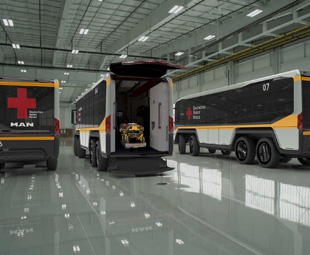A coach that could save lives

An idea of a student at Offenbach University of Art and Design, Johannes Schmutzler, known as the flexHVC – or Flexible Humanitarian Vehicle Concept – is showing the possibilities for a vehicle concept tailored to humanitarian aid requirements.
As the subject of his graduation thesis, Schmutzler came up with the idea for an all-terrain coach, which can be used to transport sick or injured patients and serve as a mobile care and surgical centre in crisis-torn areas. He was given support by the bus and coach experts at MAN Truck & Bus.
“The flexHVC is based on this flexibility, and on the spaciousness and extensive possibilities offered by a coach”, explains Stephan Schönherr, vice president design, bus, at MAN Truck & Bus.
The all-terrain MAN GL 8×8 with front-mounted engine was chosen as the chassis. The modular body allows 6×6 or 4×4 models to be deployed depending on needs.
To protect the crew in war-torn regions, the vehicle has an armoured floor and extra cab protection. The large centre door is a fast, easy entrance and exit point for emergency and aid staff.
The exterior of the vehicle is designed to ensure that it and its function are immediately recognisable in any cultural environment without the need for written signage.
The flexHVC is divided into three separate areas. A living unit for up to four people and the cab are situated at the front, but it’s the rear of the coach that reveals its highly specialised nature. Here, a system of rails is fitted that enables two “modules” (in the four-axle model) to be loaded into the vehicle from the rear.
 The modules can contain a variety of equipment and features and can be aligned to the specific requirements of the situation. One module type can be fitted with up to six beds, enabling the flexHVC to carry a maximum of twelve beds if needed for transporting sick or injured patients.
The modules can contain a variety of equipment and features and can be aligned to the specific requirements of the situation. One module type can be fitted with up to six beds, enabling the flexHVC to carry a maximum of twelve beds if needed for transporting sick or injured patients.
Other possible modules contain a fully equipped operating centre, or basic medical equipment. Medical professionals can thus use the flexHVC as a base to carry out general medical examinations and X-rays, as well as emergency surgery, while being completely mobile.
“The flexHVC could be used for many different purposes in both civilian and military settings. The unconventional design concept opens completely new perspectives concerning mobility and growing global challenges. It points the way to the future,” says Schönherr.
Mindful of the need to transport the coaches to the regions where they would be needed, Schmutzler designed the vehicle dimensions to enable them to be shipped in standard ISO containers.
The student paid particular attention to the exterior of his vehicle and its impact on the public. “Coaches are not associated with negative emotions and are generally not perceived as threatening, unlike many other types of vehicle. This is a major advantage,” explains Schönherr.
“University projects of this kind are a definite win-win situation. For the MAN design team, it’s always refreshing to experience the wealth of creativity in students’ ideas and enter this world of young designers and users.
“They also offer students the chance to discuss ideas with MAN designers, gather experience and familiarise themselves with the challenges of daily design routine at a major commercial-vehicle manufacturer,” enthuses Schönherr.
Published by
Focus on Transport
focusmagsa



